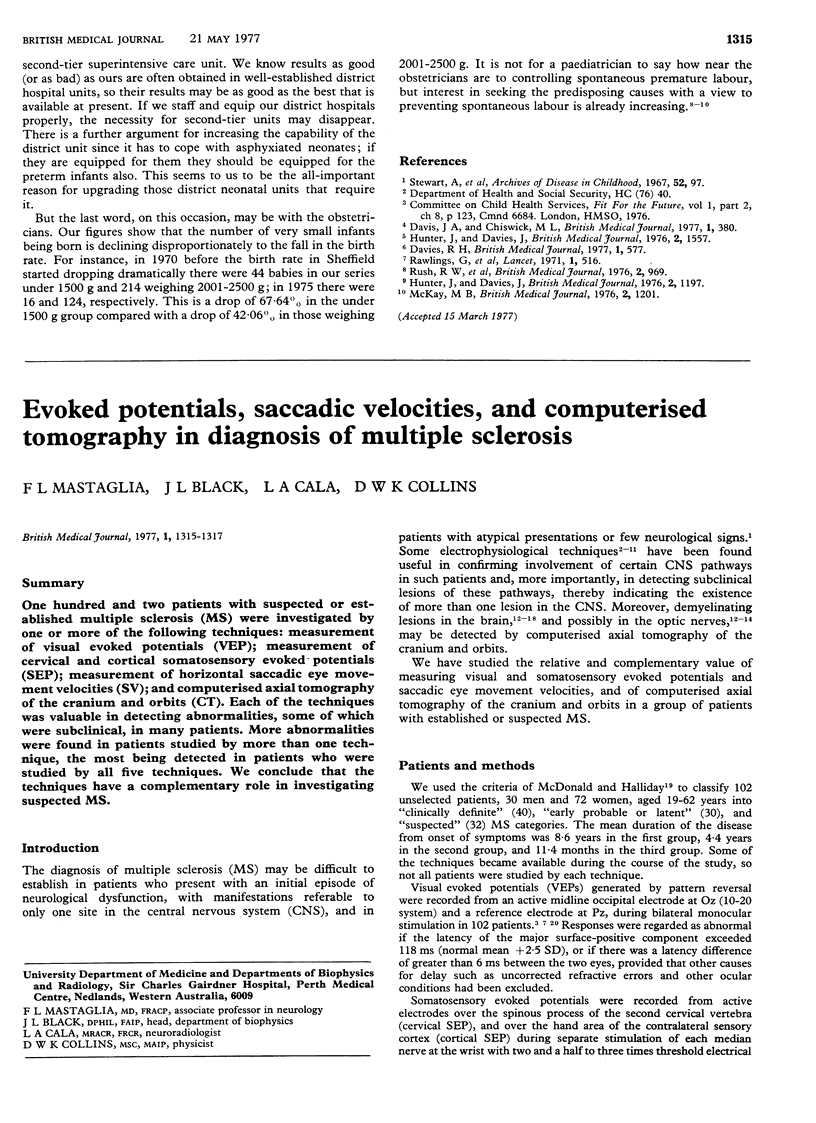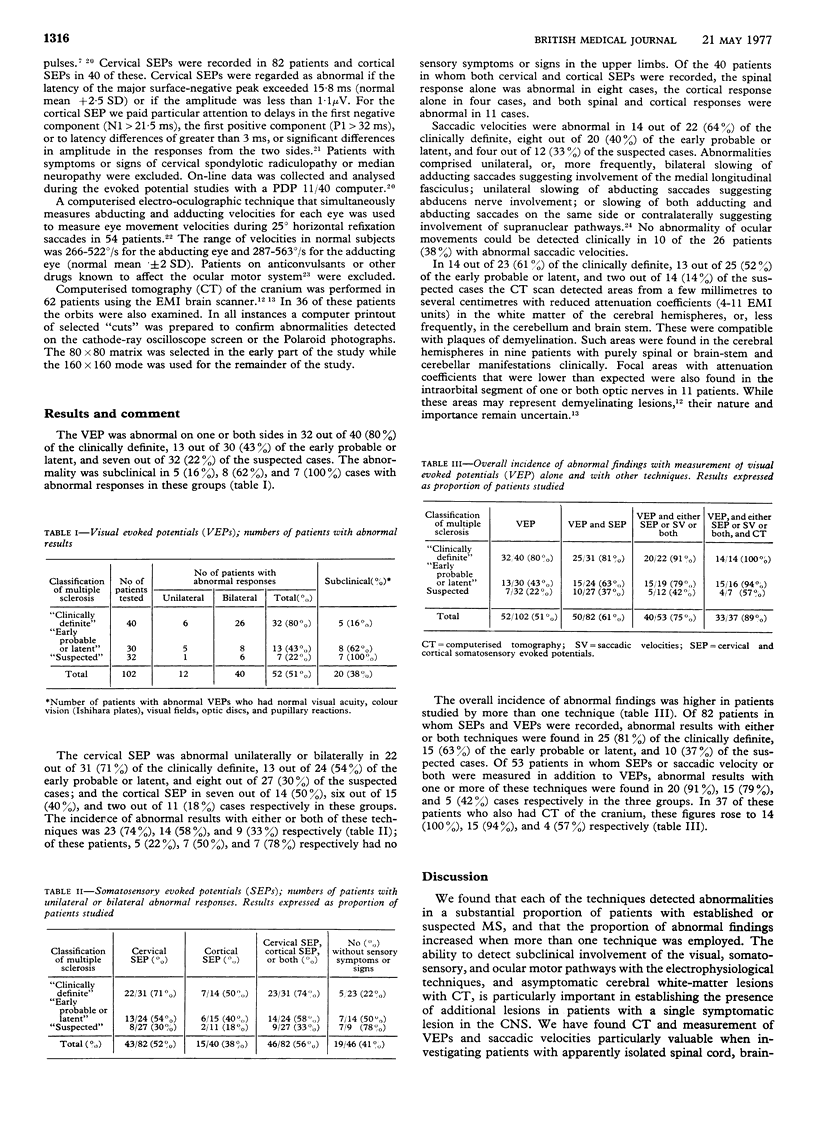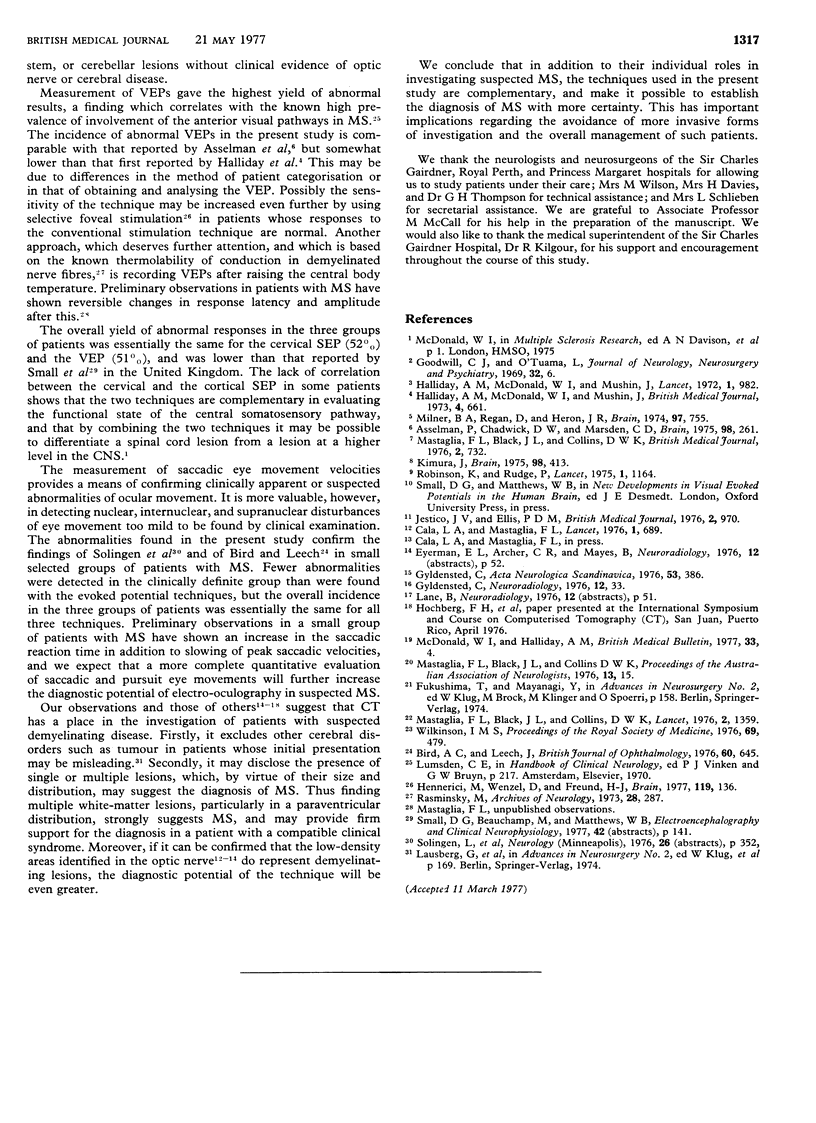Abstract
One hundred and two patients with suspected or established multiple sclerosis (MS) were investigated by one or more of the following techniques: measurement of visual evoked potentials (VEP); measurement of cervical and cortical somatosensory evoked potentials (SEP); measurement of horizontal saccadic eye movement velocities (SV); and computerised axial tomography of the cranium and orbits (CT). Each of the techniques was valuable in detecting abnormalities, some of which were subclinical, in many patients. More abnormalities were found in patients studied by more than one technique, the most being detected in patients who were studied by all five techniques. We conclude that the techniques have a complementary role in investigating suspected MS.
Full text
PDF


Selected References
These references are in PubMed. This may not be the complete list of references from this article.
- Asselman P., Chadwick D. W., Marsden D. C. Visual evoked responses in the diagnosis and management of patients suspected of multiple sclerosis. Brain. 1975 Jun;98(2):261–282. doi: 10.1093/brain/98.2.261. [DOI] [PubMed] [Google Scholar]
- Bird A. C., Leech J. Internuclear ophthalmoplegia. An electro-oculographic study of peak angular saccadic velocities. Br J Ophthalmol. 1976 Sep;60(9):645–651. doi: 10.1136/bjo.60.9.645. [DOI] [PMC free article] [PubMed] [Google Scholar]
- Cala L. A., Mastaglia F. L. Computerised axial tomography in multiple sclerosis. Lancet. 1976 Mar 27;1(7961):689–689. doi: 10.1016/s0140-6736(76)92797-5. [DOI] [PubMed] [Google Scholar]
- Gyldensted C. Computer tomography of the brain in multiple sclerosis. A radiological study of 110 patients with special reference to demonstration of cerebral plaques. Acta Neurol Scand. 1976 May;53(5):386–389. doi: 10.1111/j.1600-0404.1976.tb04356.x. [DOI] [PubMed] [Google Scholar]
- Gyldensted C. Computer tomography of the cerebrum in multiple sclerosis. Neuroradiology. 1976 Oct 27;12(1):33–42. doi: 10.1007/BF00344224. [DOI] [PubMed] [Google Scholar]
- Halliday A. M., McDonald W. I., Mushin J. Delayed visual evoked response in optic neuritis. Lancet. 1972 May 6;1(7758):982–985. doi: 10.1016/s0140-6736(72)91155-5. [DOI] [PubMed] [Google Scholar]
- Halliday A. M., McDonald W. I., Mushin J. Visual evoked response in diagnosis of multiple sclerosis. Br Med J. 1973 Dec 15;4(5893):661–664. doi: 10.1136/bmj.4.5893.661. [DOI] [PMC free article] [PubMed] [Google Scholar]
- Hennerici M., Wenzel D., Freund H. J. The comparison of small-size rectangle and checkerboard stimulation for the evaluation of delayed visual evoked responses in patients suspected of multiple sclerosis. Brain. 1977 Mar;100(Pt 1):119–136. doi: 10.1093/brain/100.1.119. [DOI] [PubMed] [Google Scholar]
- Jestico J. V., Ellis P. D. Changes in nystagmus on raising body temperature in clinically suspected and proved multiple sclerosis. Br Med J. 1976 Oct 23;2(6042):970–972. doi: 10.1136/bmj.2.6042.970. [DOI] [PMC free article] [PubMed] [Google Scholar]
- Kimura J. Electrically elicited blink reflex in diagnosis of multiple sclerosis. Review of 260 patients over a seven-year period. Brain. 1975 Sep;98(3):413–426. doi: 10.1093/brain/98.3.413. [DOI] [PubMed] [Google Scholar]
- Mastaglia F. L., Black J. L., Collins D. W. Saccadic velocities in multiple sclerosis. Lancet. 1976 Dec 18;2(7999):1359–1359. doi: 10.1016/s0140-6736(76)92012-2. [DOI] [PubMed] [Google Scholar]
- Mastaglia F. L., Black J. L., Collins D. W. Visual and spinal evoked potentials in diagnosis of multiple sclerosis. Br Med J. 1976 Sep 25;2(6038):732–732. doi: 10.1136/bmj.2.6038.732. [DOI] [PMC free article] [PubMed] [Google Scholar]
- McDonald W. I., Halliday A. M. Diagnosis and classification of multiple sclerosis. Br Med Bull. 1977 Jan;33(1):4–9. [PubMed] [Google Scholar]
- Milner B. A., Regan D., Heron J. R. Differential diagnosis of multiple sclerosis by visual evoked potential recording. Brain. 1974 Dec;97(4):755–772. doi: 10.1093/brain/97.1.755. [DOI] [PubMed] [Google Scholar]
- Rasminsky M. The effects of temperature on conduction in demyelinated single nerve fibers. Arch Neurol. 1973 May;28(5):287–292. doi: 10.1001/archneur.1973.00490230023001. [DOI] [PubMed] [Google Scholar]
- Robinson K., Rudge P. Auditory evoked responses in multiple sclerosis. Lancet. 1975 May 24;1(7917):1164–1166. doi: 10.1016/s0140-6736(75)93138-4. [DOI] [PubMed] [Google Scholar]
- Wilkinson I. M. The influence of drugs and alcohol upon human eye movement. Proc R Soc Med. 1976 Jul;69(7):479–480. [PMC free article] [PubMed] [Google Scholar]


